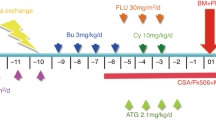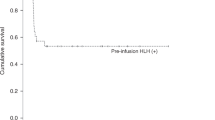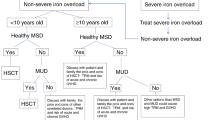Summary:
Since the results of conventional hematopoietic stem-cell transplantation (HSCT) for patients with dyskeratosis congenita (DC) are poor owing to the high incidence of transplant-related complications, we explored the use of a low-intensity HSCT regimen. We report two children with DC with severe cytopenia, who underwent successful HSCT from a matched unrelated donor after conditioning with fludarabine, cyclophosphamide, and antithymocyte globulin. Graft-versus-host-disease (GVHD) prophylaxis consisted of corticosteroids and cyclosporin A. The regimen was well tolerated, no significant transplant-related complications were observed, and engraftment was rapid and complete. At 15 and 16 months after HSCT, the children were fully engrafted, in excellent clinical condition, full-donor chimerism, and no signs of GVHD. We conclude that a low-intensity regimen is sufficient to induce durable engraftment using matched unrelated donor HSCT in DC patients, with minimal 1-year transplant-related toxicity. Longer follow-up will determine whether this regimen also reduces long-term toxicity.
This is a preview of subscription content, access via your institution
Access options
Subscribe to this journal
Receive 12 print issues and online access
$259.00 per year
only $21.58 per issue
Buy this article
- Purchase on Springer Link
- Instant access to full article PDF
Prices may be subject to local taxes which are calculated during checkout
Similar content being viewed by others
References
Drachtman RA, Alter BP . Dyskeratosis congenita: clinical and genetic heterogeneity. Report of a new case and review of the literature. Am J Pediatr Hematol Oncol 1992; 14: 297–304.
Knight S, Vulliamy T, Copplestone A et al. Dyskeratosis Congenita (DC) Registry: identification of new features of DC. Br J Haematol 1998; 103: 990–996.
Dokal I . Dyskeratosis congenita in all its forms. Br J Haematol 2000; 110: 768–779.
Rocha V, Devergie A, Socié G et al. Unusual complications after bone marrow transplantation for dyskeratosis congenita. Br J Haematol 1998; 103: 243–248.
Slavin S, Nagler A, Naparstek E et al. Nonmyeloablative stem cell transplantation and cell therapy as an alternative to conventional bone marrow transplantation with lethal cytoreduction for the treatment of malignant and nonmalignant hematologic diseases. Blood 1998; 91: 756–763.
Horwitz ME, Barrett AJ, Brown MR et al. Treatment of chronic granulomatous disease with nonmyeloablative conditioning and a T-cell–depleted hematopoietic allograft. N Engl J Med 2001; 344: 881–888.
Giralt S, Estey E, Albitar M et al. Engraftment of allogeneic hematopoietic progenitor cells with purine analog-containing chemotherapy: harnessing graft-versus-leukemia without myeloablative therapy. Blood 1997; 89: 4531–4536.
Nagler A, Aker M, Or R et al. Low-intensity conditioning is sufficient to ensure engraftment in matched unrelated bone marrow transplantation. Exp Hematol 2001; 29: 362–370.
Chan KW, Li CK, Worth LL et al. A fludarabine-based conditioning regimen for severe aplastic anemia. Bone Marrow Transplant 2001; 27: 125–128.
Amrolia P, Gaspar HB, Hassan A et al. Nonmyeloablative stem cell transplantation for congenital immunodeficiencies. Blood 2000; 96: 1239–1246.
Knight SW, Heiss NS, Vulliamy TJ et al. X-linked dyskeratosis congenita is predominantly caused by missense mutations in the DKC1 gene. Am J Human Genetics 1999; 65: 50–58.
Vulliamy T, Marrone A, Goldman F et al. The RNA component of telomerase is mutated in autosomal dominant dyskeratosis congenita. Nature 2001; 413: 432–435.
Bryant E, Martin PJ . Documentation of engraftment and characterization of chimerism following hematopoietic cell transplantation. In: Thomas ED, Blume KG, Forman SJ (eds) Hematopoietic Cell Transplantation, 2nd edn. Blackwell Science: Boston, 1999, pp. 197–206.
Kernan NA, Bartsch G, Ash RC et al. Analysis of 462 transplantations from unrelated donors facilitated by the National Marrow Donor Program. N Engl J Med 1993; 328: 593–602.
Anasetti C, Beatty PG, Storb R et al. Effect of HLA incompatibility on graft-versus-host disease, relapse, and survival after marrow transplantation for patients with leukemia or lymphoma. Hum Immunol 1990; 29: 79–91.
Berthou C, Devergie A, D'Agay MF et al. Late vascular complications after bone marrow transplantation for dyskeratosis congenita. Br J Haematol 1991; 79: 335–336.
Dokal I, Bungey J, Williamson P, et al. Oscier D, Hows J, Luzzatto L . Dyskeratosis congenita fibroblasts are abnormal and have unbalanced chromosomal rearrangements. Blood 1992; 80: 3090–3096.
Forni GL, Melevendi C, Jappelli S et al. Dyskeratosis congenita: unusual presenting features within a kindred. Pediatric Hematol Oncol 1993; 10: 145–149.
Lau YL, Ha SY, Chan CF et al. Bone marrow transplant for dyskeratosis congenita [letter]. Br J Haematol 1999; 105: 571.
Yabe M, Yabe H, Hattori K et al. Fatal interstitial pulmonary disease in a patient with dyskeratosis congenita after allogeneic bone marrow transplantation. Bone Marrow Transplant 1997; 19: 389–392.
Phillips RJ, Judge M, Webb D et al. Dyskeratosis congenita: delay in diagnosis and successful treatment of pancytopenia by bone marrow transplantation. Br J Dermatol 1992; 127: 278–280.
Langston AA, Sanders JE, Deeg HJ et al. Allogeneic marrow transplantation for aplastic anaemia associated with dyskeratosis congenita. Br J Haematol 1996; 92: 758–765.
Ghavamzadeh A, Alimoghadam K, Nasseri P et al. Correction of bone marrow failure in dyskeratosis congenita by bone marrow transplantation. Bone Marrow Transplant 1999; 23: 299–301.
Shaw PH, Haut PR, Olszewski M et al. Kletzel M . Hematopoietic stem-cell transplantation using unrelated cord-blood versus matched sibling marrow in pediatric bone marrow failure syndrome: one center's experience. Pediatr Transplant 1999; 3: 315–321.
Conter V, Johnson EL, Paolucci P et al. Bone marrow transplantation for aplastic anemia associated with dyskeratosis congenita. Am J Pediatric Hematol/Oncol 1988; 10: 99–102.
Catani L, Gugliotta L, Vianelli N et al. Endothelium and bone marrow transplantation. Bone Marrow Transplant 1996; 17: 277–280.
Dokal I, Manning R, Laffan M . Elevated levels and multimer pattern of von Willebrand factor in patients with dyskeratosis congenita [abstract #122]. Br J Haematol 1995; 89 (S1): 33.
Paul SR, Perez-Atayde A, Williams DA . Interstitial pulmonary disease associated with dyskeratosis congenita. Am J Pediatr Hematol/Oncol 1992; 14: 89–92.
Gluckman E, Auerbach AD, Horowitz MM et al. Bone marrow transplantation for Fanconi anemia. Blood 1995; 86: 2856–2862.
Dokal I, Luzzatto L . Dyskeratosis congenita is a chromosomal instability disorder. Leuk Lymphoma 1994; 15: 1–7.
Vulliamy TJ, Knight SW, Mason PJ et al. Very short telomeres in the peripheral blood of patients with x-linked and autosomal dyskeratosis congenita. Blood Cells Mol Dis 2001; 27: 353–357.
Wynn R, Thornley I, Freedman M et al. Telomere shortening in leucocyte subsets of long-term survivors of allogeneic bone marrow transplantation. Br J Haematol 1999; 105: 997–1001.
Kapelushnik J, Or R, Slavin S et al. A fludarabine-based protocol for bone marrow transplantation in Fanconi's anemia. Bone Marrow Transplant 1997; 20: 1109–1110.
Aker M, Varadi G, Slavin S et al. Fludarabine-based protocol for human umbilical cord blood transplantation in children with Fanconi anemia. J Pediatric Hematol Oncol 1999; 21: 237–239.
Mahmoud HK, Schaefer UW, Schmidt CG et al. Marrow transplantation for pancytopenia in dyskeratosis congenita. Blut 1985; 51: 57–60.
Acknowledgements
This paper was prepared with the assistance of Editorial Services, The Hospital for Sick Children, Toronto, Ontario, Canada.
Author information
Authors and Affiliations
Rights and permissions
About this article
Cite this article
Dror, Y., Freedman, M., Leaker, M. et al. Low-intensity hematopoietic stem-cell transplantation across human leucocyte antigen barriers in dyskeratosis congenita. Bone Marrow Transplant 31, 847–850 (2003). https://doi.org/10.1038/sj.bmt.1703931
Received:
Accepted:
Published:
Issue Date:
DOI: https://doi.org/10.1038/sj.bmt.1703931
Keywords
This article is cited by
-
Clinical Utility of Next-Generation Sequencing in Acute Myeloid Leukemia
Molecular Diagnosis & Therapy (2020)
-
Allogeneic hematopoietic stem cell transplantation for inherited bone marrow failure syndromes
International Journal of Hematology (2016)
-
Reduced intensity conditioning is effective for hematopoietic SCT in dyskeratosis congenita-related BM failure
Bone Marrow Transplantation (2013)
-
A reduced intensity conditioning regimen of fludarabine, cyclophosphamide, antithymocyte globulin, plus 2 Gy TBI facilitates successful hematopoietic cell engraftment in an adult with dyskeratosis congenita
Bone Marrow Transplantation (2012)
-
Disease-specific hematopoietic cell transplantation: nonmyeloablative conditioning regimen for dyskeratosis congenita
Bone Marrow Transplantation (2011)



